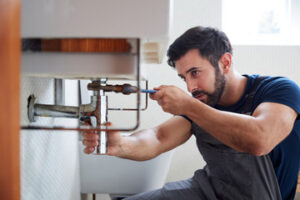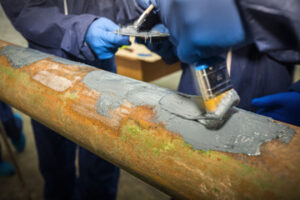Plumbing is the system of pipes and fixtures that provide water for drinking, cooking, bathing, washing clothes, and flushing sewage. Plumbers install, repair, and maintain these systems.

Learning plumbing from a book or online can help you understand the basics, but there is no substitute for hands-on experience. For professional help, contact Plumbing Express, Inc. for more details.
Clogged drains are one of the most common plumbing problems. A clog slows down the movement of wastewater, which can affect water flow in sinks, bathtubs and showers. It can also cause sewage to back up into sinks, tubs and toilets. This contaminated standing water can spread bacteria that lead to illnesses like diarrhea, gastroenteritis, cholera and salmonella. The foul odors from clogged drains can also affect your health.
You can often fix minor clogs with a plunger or hand-cranked drain snake. However, if these tools aren’t working or a backup is coming up, it is time to call a plumber. Our plumbers can determine the source of the clog and determine how to repair it.
Most clogs occur in the sewer line, but they can happen anywhere in the house’s drain system. The main sewer drain is usually the largest pipe in the home, and smaller pipes branch out from there to each fixture. The toilet is the most common place for a drain to clog, but clogs can form in any drain or fixture.
Drain clogs can create mold, which can spread throughout the house and cause respiratory problems. They can also damage the pipes and corrode them, which can lead to expensive repairs. The best way to prevent clogs is to be careful with what you put down the drains. This includes only putting food, trash and hair down the garbage disposal and using a drain strainer in the kitchen and bathrooms.
When a drain or toilet starts backing up, that’s usually a sign that the clog is deeper than you can reach with a plunger or snake. If multiple drains clog at the same time, it’s likely caused by a break or full clog further down the pipe.
If you have hard water, a water softener can help. It can reduce the amount of minerals in your water that build up and block your drains. Regular maintenance and regular professional plumbing service can also keep your drains running smoothly. A plumber can check your drains for signs of wear and tear, and recommend maintenance services to avoid clogs and leaks.
Water Leaks
Running water and sanitary sewer systems have made life more convenient but can lead to serious problems when they leak. The longer a leak goes undetected, the more damage it can cause to plumbing pipes and fixtures and building materials as well as encourage mold growth and sagging floors and ceilings. Water leaks can also rack up hefty water and waste bills.
Some leaks, such as a burst pipe in your basement, are easy to detect. But others are not, especially if they occur behind walls and other hidden areas. For example, a leak in a concealed pipe beneath your sink or behind your washing machine could go unnoticed until severe water damage occurs or you notice an unexplained increase in your water bill.
The most common leaks are from faucets, but they can also happen from toilets, showers and bathtubs or other appliances in the home. When these leaks occur, you will typically see damp patches in rooms, or there could be a musty smell or a drop in water pressure. Leaks from toilets can be particularly problematic as they are usually caused by a loose or broken toilet flange.
If you suspect you have a leak, shut off your water and call your plumber. In addition to reducing water waste and preventing costly damages, repairing a leak as soon as you notice it will help save money on your water bills.
In addition to wasting water and causing structural damage, leaking pipes can create unpleasant smells in the home as well as encourage unwanted growth. Mold, mildew and fungus that develops as a result of a leak can be extremely hazardous to your health, especially for individuals with breathing difficulties.
In addition to the obvious signs of a leak, some other common warnings include an unexplained increase in your household utility bills or if you notice stains on your ceiling or walls. These stains may be caused by corrosion or by a leak in a water line behind the wall. If you are suspicious of a possible leak, shut off all water to your home and take a look around. You should also check the areas under sinks, behind appliances and in the garage where leaks are most likely to occur.
Sewer Backups
Your sewer lines are meant to transport wastewater away from your sinks, tubs, showers and toilets. When the line becomes blocked or ruptured, it can lead to sewage backups into your home. This is a serious health issue as raw sewage contains dangerous bacteria and contaminants that can make you sick. If you notice a sewage backup, there are several signs to look out for that indicate it’s time to call a plumber.
Foul Odors
The main sign of a sewer backup is a foul smell. The odor is due to the hydrogen sulfide in sewage that’s released when it comes into contact with water. The smell will usually be strongest in your basement, laundry room or garage, as these are the areas closest to the line. Other signs of a backup include gurgling noises from drains and toilets, as well as wastewater backing up into bathtubs, showers or sinks.
Wetness Around Floor Drains
Basement rec rooms or laundry areas often have floor drains that are designed to prevent flooding. These are the first places that sewage will back up into, so it’s important to check them regularly for wetness. It’s also a good idea to regularly inspect any other lower-level rooms in your home for wet spots, as these can be early indicators of a problem with your sewer line.
Changes to Your Yard
If you’re noticing changes in your yard, it may be a sign that the sewer line is damaged. This can be caused by tree roots that grow into the line, as well as by environmental factors like flooding events. A professional plumber can help repair any damage to the sewer line and prevent future problems.
Keeping up with your plumbing maintenance is the best way to reduce the risk of sewer backups in your home. Regularly checking your drains and having a professional inspect your pipes once every few years can help. This is especially important if you have older homes with cast iron, clay or cement piping that could be at higher risk for failure. It’s also a good idea not to pour cooking grease down the drain, as this can lead to clogs and wastewater backups.
Water Heaters
Your water heater does a lot of work to keep hot running water available. It’s easy to take it for granted until something goes wrong with the amount of hot water or the water pressure. If you are dealing with these problems, it is important to get as much information as possible before calling a plumber. Here are some things to look for.
Traditional water heaters use an insulated tank to store heated water. When you turn on a faucet, cold water enters the water heater through a dip tube and the heating mechanism—whether it’s a gas burner or electric heat rods—turns on to warm up the water for your sink or shower. A thermostat keeps track of the temperature inside the storage container and when readings drop, a switch turns on the heating mechanism to warm the water back up to your preferred setting.
Tank units can operate on gas, electricity, fuel oil, and propane, but each type of energy has its own environmental impact. For instance, a gas water heater will burn natural gas to warm the water, while an electric unit will draw power from your house’s electrical system. If you are concerned about the environmental impact of your home’s appliances, it is best to choose a tankless unit that uses solar or wind energy to heat the water.
If your water heater isn’t providing enough hot water, there may be a problem with the water supply line into the house or the distribution lines within the home. Mineral deposits or clogs can slow the flow of water both into and out of the water heater, which will result in lower water pressure. It is also a good idea to have your hot water heater serviced once a year to prevent any build-up of sediment that could decrease its efficiency or cause it to overheat.
You can check the temperature of your water by opening the access panel to your heater (or removing two separate panels on larger heaters). Most tanks will have a red dial that indicates a desired temperature. This is typically set to 120 deg-140 deg, but if yours reads higher than this you should consult a professional as water temperatures that are too high can create harmful bacteria.

